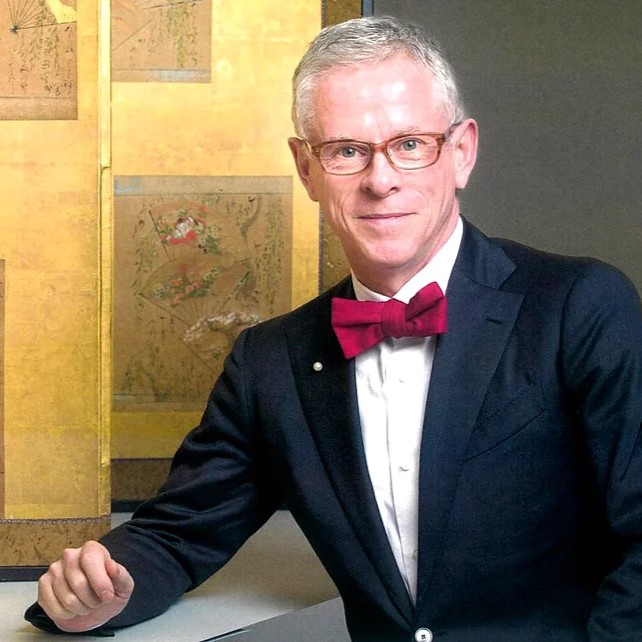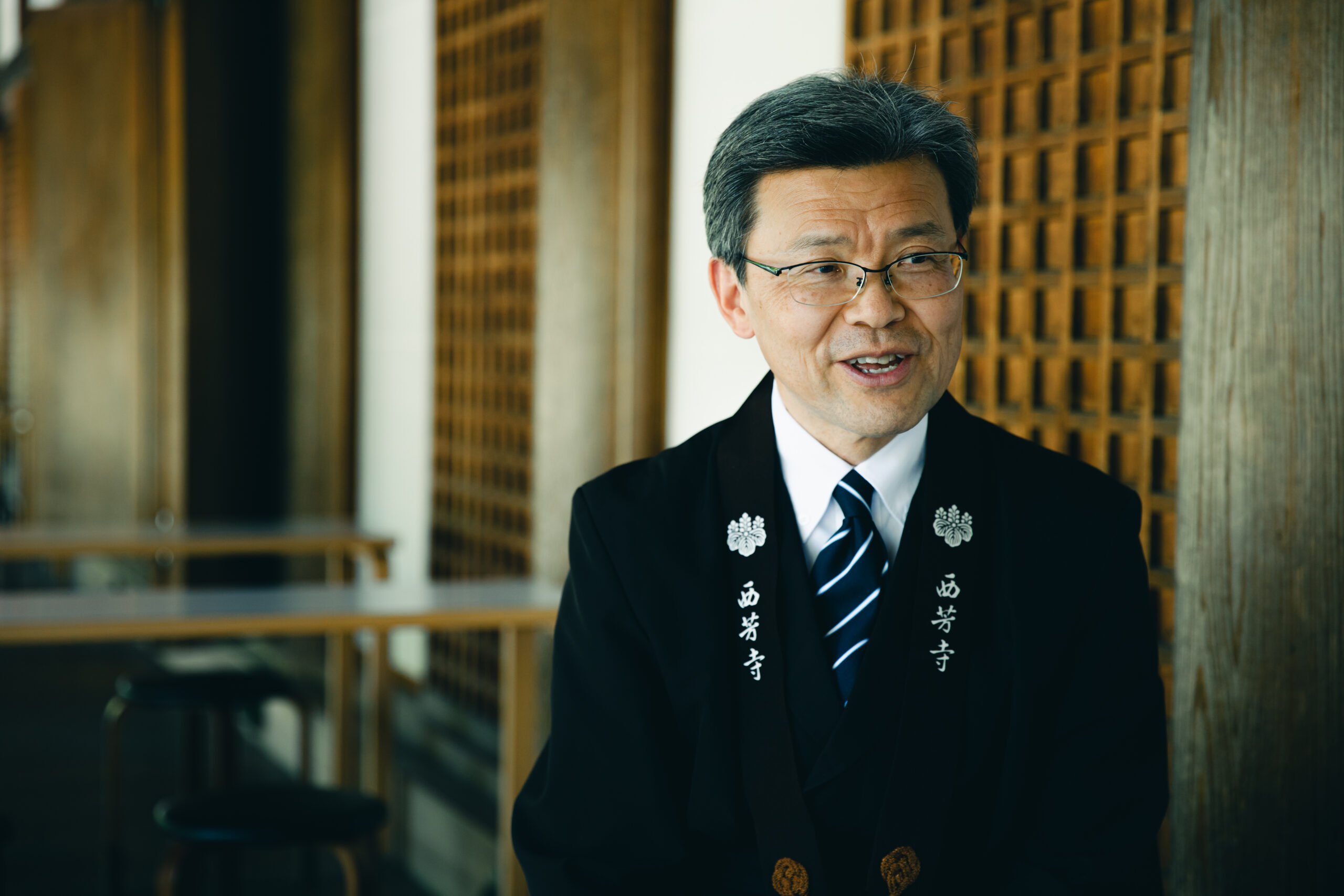2025.6.20
体露金風 西芳寺第十四景
ピーター・J・マクミラン
(翻訳家・詩人)
翻訳者であり詩人でもあるピーター・マクミラン氏が、西芳寺の魅力を綴る「体露金風 西芳寺」シリーズ。日本文化への造詣が深いピーター氏の感性と深い洞察が誘う、心の旅。ぜひ原文の美しい響きも、ご堪能ください。
過去の恩恵と共に、今を生きる
今回西芳寺を訪れた日は、雨がしとしとと降っており、これまでにないほど鮮やかな緑に、すべてが包まれていました。一方で、地面はより黒く、樹皮はより暗く、コントラストがより鮮明に浮かびます。やさしい雨に、私はふと、遠い昔にアイルランドで過ごした子ども時代の雨を思い出します。アイルランドでは年中、よく雨が降っています。そして私は、はるか昔の西芳寺へと思いを馳せました。
西芳寺は、悠久の歴史が息づく地に包まれています。今回は秦河勝を紹介させてください。一説によると、西芳寺には聖徳太子の別荘があったと伝えられています。河勝について知ることで、西芳寺ができた時代のこの地の様子を垣間見ることができます。

秦氏は、秦の始皇帝を祖に持つとされる一族。古墳時代に朝鮮半島から移住し、日本に定住しました。秦氏の本家は、山城国と呼ばれる現在の嵐山、嵯峨、太秦など桂川沿いの地域、そして京都市の右京区や伏見区に拠点を置いていました。
秦氏はそれ以前から日本にいたようですが、5世紀後半の雄略天皇の時代に一族として確立したと考えられています。時の権力者であった秦酒公は、雄略天皇に大量の絹を献上しました。西芳寺の近くにある「太秦」という地名は、中国の漢字「堆く」に由来するそうで、高く積み上げることを意味し、献上された絹が高く積まれている様子と繋がります。太秦は現在、映画撮影の聖地として知られており、一時期は「日本のハリウッド」と称されていました。
秦氏の中でも特に著名な人物が、秦河勝です。河勝について記した伝書は、猿楽との繋がりを含めて多数あり、聖徳太子と親しい仲にあったと言われています。また、京都最古のお寺である蜂岡寺(現在の広隆寺)を建立したとも考えられています。河勝は7世紀初頭、聖徳太子より仏像を授かり、広隆寺を建てました。境内で最も有名な仏像は、宝冠弥勒として知られる弥勒菩薩半跏思惟像。国宝に指定されており、国内で最も美しい仏像のひとつです。広隆寺には今でも聖徳太子の幼少期の像が安置されています。西芳寺の帰りに、ぜひ立ち寄ってみてください。河勝と聖徳太子はかつて、西芳寺の近くで一緒にお茶を飲んでいたかもしれません。そんな様子を思い浮かべるのも、すてきなものです。

西芳寺は禅寺です。坐禅は、今の瞬間に意識を向けることが大切だと言われたりしますが、過ぎ去った時代を学ぶことで歴史的背景が浮かび上がり、西芳寺への理解を深め、近隣地域との繋がりを知ることができます。今回紹介したのは、この地が持つ歴史の中でも、ひとつの地域とひとりの人物に過ぎません。
過去への理解が現在に繋がるということは、私たちの日常生活にも落とし込める教訓があるのではないでしょうか。確かに、一瞬一瞬を懸命に生きることは大切です。しかし、今の私たちがあるのは、私たち自身の過去と先人たちの過去があってこそ。いい思い出もあれば、失敗や間違いもあったかもしれません。ですが、失敗や間違いはいつだって乗り越えてゆけます。ですから、不完全も含むすべての過去を讃えながら、今この瞬間を豊かに生きてゆきましょう。
Living in the Now while Honoring the Past
Today a light rain is falling as I visit, bathing all in the greenest green but also making the earth look blacker and the barks of trees dark and the contrasts sharper. It is a soft rain and reminds me of the rains of the distant past of my childhood in Ireland, where it rains on many days of the year. And it also made me wonder what the distant past was like in Saihoji.
Saihoji is cradled in an area with a deep and ancient history. On this occasion I would like to introduce the Hata clan and Hata no Kawakatsu who was close to the famous crown prince Shotoku Taishi of the Nara period. Shotoku Taishi, who penned the first constitution of Japan, is one of the most famous figures in Japanese history, and according to one tradition there used to be a villa of Shotoku Taishi in the area near Saihoji. By learning about Kawakatsu we can get a glimpse of the period when Saihoji was established.
In the Kofun period (from the 3rd to 7th century), the Hata clan, which claimed descent from Qin Shi Huang the first emperor of the Qin Dynasy, migrated from the Korean Peninsula and settled in Japan. The main branch of the Hata clan settled in Yamashiro Province or present day Arashiyama, Saga, Uzumasa, etc., along the Katsura River and in the present-day Ukyo Ward of Kyoto City and around the present-day Fushimi Ward.
Though in Japan since before that time, the Hata clan is believed to have been established in the late 5th century during the reign of Emperor Yuryaku. Hata no Sake no Kimi, a powerful figure of the time, presented a huge amount of silk to the Emperor Yuryaku. The name of the nearby town of Uzumasa is said to derive from the Chinese character uzutakaku (堆く) which means “to pile up high,” just as the great amount of donated silk was piled up high. These days Uzumasa is famous for a sacred place for movie sets and was once known as the Hollywood of Japan.
One of the most famous members of the clan was Hata no Kawakatsu. Many legends surround him, including his connection to Sarugaku, and he was said to be close to Shotoku Taishi. He is also said to have established the oldest Buddhist temple in Kyoto, Hachioka Temple (now known as Koryu-ji Temple). Kawakatsu was granted a Buddha statue by Prince Shotoku at beginning of the 7th century and established the temple. One of its most famous Buddhist sculptures is the Crowned Maitreya. It is a national treasure and is one of the most beautiful Buddhist sculptures in all of Japan. I hope visitors can see it on their way home from Saihoji. I like to think of Kawakatsu and Shotoku Taishi having tea together in or near Saihoji all those years ago.
We think of the practice of Zen of focusing on the present moment. But reading about the ancient past creates a historical context that can deepen our understanding of Saihoji and understand its relation to the local area and community. Today I introduced just one town and one character from the ancient history of the area.
Thinking about that made me realize that there is also a lesson for us too. Though we should aim to live fully in each moment, we should also recognize that it is our past and the past of our ancestors that have made us the persons we are today. Sometimes there may be nice memories but sometimes there may be mistakes or even sins in our past. But we can always atone for the mistakes of our past. So, let’s aim to live a rich life in the present that honors our own past, warts and all.
Peter MacMillan ピーター・J・マクミラン
翻訳家・詩人。株式会社 月の舟(制作・翻訳会社) 代表取締役。
2008年に英訳『百人一首』を出版し、日米で翻訳賞を受賞。2016年9月には英訳『The Tales of Ise』(伊勢物語)、2017年には英訳『One Hundred Poets One Poem Each(新訳)』の2冊がPenguin Booksより出版される。近著に『日本の古典を英語で読む』『英語で味わう万葉集』など著書多数。2019年より朝日新聞にて「星の林に」、2022年より京都新聞にて「不思議の国の和歌ワンダーランド 英語で読む百人一首」を連載。

翻訳:福田安奈






